An Introduction to Systemic
Functional Linguistics
2nd Edition
Suzanne Eggins
\ continuum
• Of NEW Y O RK
• L O N D ON
�
To my teachers and my students
Contents
List of Texts
List of Systems
List of Figures
List of Tables
Foreword to the Second Edition
Acknowledgements
An overview of systemic functional linguistics
Chapter 1
Chapter 2 What is (a) text?
Chapter 3
Chapter4
Chapter 5
Chapter 6
Chapter 7
Chapter 8
Chapter 9
Chaptet 10 The grammar of textual meaning: THEME
Chapter 11 Explaining text: applying SPL
Genre: context of culture in text
Register: context of situation in text
Introduction to the lexico-grammar
The grammar of interpersonal meaning: MOOD
Systems: meaning as choice
The grammar of experiential meaning; TRANSITIVITY
The grammar of logical meaning: CLAUSE COMPLEX
Appendix: analyses of the Crying Baby texts
References
Index
Continuum international Publishing Group
The Tower Building
11 York Road
London SE1 7NX
15 Em 2 6 th S [ r e et
New York
j ^y 10010
© Suzanne Eggins 2004
All rights reserved. No part of this publication may be reproduced or transmitted in any form
or by any means, electronic or mechanical, including photocopying, recording, or any infor
mation storage or rerrieval system, without prior permission in writing from the publishers.
British Library Cataloguing-in-Publication Data
A catalogue record for this book is available from the British Library.
ISBN: 0-8264-5787-8 (hardback)
0-8264-5786-X (paperback)
Library of Congress Cat a loging-in-Publi cation Data
A catalogue record for this book is available from the Library of Congress
Typeset by Servis Filmserting Ltd, Manchester
Printed and bound in Great Britain by
MPG Books Ltd, Bodmin, Cornwall
�
Texts
1.1 Crying Baby text 1
1.2 Crying Baby text 2
1.3 Crying Baby text 3
2.1 Poem by e. e. cummings
2.2 Excerpt from The BPG
2.3 Excerpt from 'Stalin's Genius' by Bruce Andrews
2.4 The Story of an Hour
2.5 Fatal Alaska
2.6 The Grapevine
3.1 Threshold
3.2 Post Office Transaction
3.3 Service Transaction over the Phone
3.4 Spinach Risotto
3.5 Fatal Alaska reordered, with schematic structure labelled
3.6 An excerpt from genre fiction
3.7 Inside Edge
4.1 Sign
4.2 Late Essays
4.3 Late Essays (unpacked)
4.4 PC Care
4.5 The Bermuda Bowl
4.6 Excerpt from Marston's Bridge Workbook for Beginners
5.1 Late Assignments
6.1 Henry James
8.1 Giving Blood
9.1 Shot
9.2 Interview with Gail Bell
10.1 Modified text 1.2
�
Systems
Figures
1.1 Traffic lights
1.2 Semiotic system of traffic lights
1.3 Lexical choke, specifying sex
1.4 Lexical choice, specifying attitude
1.5 Grammatical choke
5.1 Extending the traffic light system
5.2 Combining expressions in the traffic light system
7.1 Original traffic light system
7.2 Changing a realization in the traffic light system
7.3 A two-sign system of traffic lights
7.4 Basic system
7.5 Traffic lights as a system
7.6 A non-binary system
7-7 Simultaneous choice
7.8 Example of simultaneous choice
7.9 Extending the system in delicacy
7.10 Simultaneous choice and increased delicacy
7.11 Example of an extended system network
7.12 Linguistic network
7.13 Mood network with realizations
7.14 System of personal pronouns
7.15 Alternative drawing of system of personal pronouns
7.16 "WH-compIement system
7,17 Speech function system (discourse-semantic stratum)
8.1 Transitivity
8.2 System of Circumstance
8.3 Relational processes
9.1 System of the clause complex
10.1 Theme
13
14
16
16
19
114
114
189
189
189
194
194
195
195
196
197
197
198
199
199
202
202 '
203
203
214
223
239
259
299
1.1 Content and expression in a two-level semiotic system
1.2 Content and expression in traffic lights and language
1.3 Levels or strata of language
4.1 Spatial or interpersonal distance
4.2 The expetiential distance continuum
4.3 The power continuum
4.4 The contact continuum
4.5 The affective involvement continuum
4.6 The field continuum
4.7 Bridge player's taxonomy of bridge
4.8 Non-player's taxonomy of bridge
4.9 Context in relation to language
4.10 Context, semantics and lexico-grammar
5.1 The meanings of John
7.1 Axes of chain and choice
10.1 The zig-zag pattern of Thematic development
10.2 The multiple-Rheme pattern of Thematic development
�
9.4 Logico-semantic relations in Texts 9-1 and 9.2
10.1 Examples of unmarked Theme
11.1 Mood In the Crying Baby texts
11.2 Modality and polarity in the Crying Baby texts
11.3 Types of Adjuncts in the Crying Baby texts
11.4 Categories of Mood Adjuncts in the texts
11.5 Transitivity in the Crying Baby texts
11.6 Circumstances in the Crying Baby texts
11.7 Basic clause complex summary of the Crying Baby texts
11.8 Taxis in the Crying Baby texts
11.9 Logico-semantic relations in the Crying Baby texts
1.10 THEME in the Crying Baby texts
1.11 Lexico-grammatical summaty of the Crying Baby texts
1.12 Conjunctive telations in the Crying Baby texts
1.1? Reference chains in the Crying Baby texts
1.14 Lexical strings in the Crying Baby texts
1.15 Cohesive characterizations of the Crying Baby texts
1.16 Register description of the texts
Tables
2.1 The units of the lexico-grammatical rank scale
2.2 Simple and complex realizations of lexical content
3.1 Formal vs functional criteria
3.2 Symbols used to describe schematic structure
4.1 Mode: characteristic, of spoken/written language situations
4.2 Characteristic features of spoken and written language
4.3 Contrasts between spoken and written examples
4 4 Summarizing differences between spoken and written examples
4.5 Contrasting lexical density
4.6 Contrasting grammatical intricacy
4.7 Density and intricacy in spoken and written language
4.8 Formal vs informal situations
4.9 Formal vs informal language
4.10 Technical vs everyday situations
4.11 Technical vs everyday language
5.1 Arranging words in structures
5.2 Units and criteria of graphological expression
5.3 Rank scale of the phonological stratum
3.4 Initial list of content units in Text 5.1
5.5 Rank scale at the lexico-grammatkal stratum in a systemic approach
5.6 Examples of form/class labels at each rank
5.7 Examples of function labels at each rank
6.1 Speech roles and commodities in interaction
6.2 Speech function pairs
6.3 Speech functions and typical mood of clause
6.4 Summary of dialogue
6.5 Summary of types of Adjuncts
S. I Intensive Attributive verbs
8.2 Intensive Identifying verbs
9.1 Hailiday's clause nexus
9.2 Basic clause complex summary ofTexts 9.1 and 9 2
9.3 Taxis in Texts 9-1 and 9.2
26
"44
61
64
92
93
95
95
97
98
101
^
109
110
117
122
\H
,TT
lj
Ar
Ul
~T
?q*
J?,
Ay4
�
Foreword to the Second Edition
As with the first edition, this second edition of An Introduction to Systemic Functional
Linguistics offers an overview of systemic theory and some demonstration of how systemic
techniques can be applied in the analysis of texts. Written for students who may have little
or no formal knowledge of linguistics, it covers most of the major concepts in systemic lin
guistics {setniotk system, genre, register, text, cohesion, grammatical metaphor. , .). Taking Michael
Halliday's An Introduction to Functional Grammar as its base, the book presents a functional
grammatical description of die simultaneous metafiractional organization of the clause (its
MOOD, TRANSITIVITY, THEME and CLAUSE COMPLEX systems) and introduces the
basic techniques for analysing cohesive patterns in text (reference, lexical cohesion and con
junction).
In the ten years since the first edition, much has happened to systemic linguistics and
to me. Since 1994, systemic functional linguistics (SFL) has moved from 'marginal' to
'mainstream' as an approach to language, at least in Australia, Systemic linguists now
hold senior positions at universities in countries around the world, and SFL informs many
postgraduate applied linguistics and TESOL programmes in English-language countries,
The past ten years have seen a corresponding outburst of publishing in SPL, from work
books in the grammar and discourse, such as Martin etal. 1997, to major theoretical works,
such as Halliday and Matchiessen 1999, and the progressive publication of Halliday's col
lected works edited by Jonathan Webster (Halliday and Webster 2002a, 2002b, 2003a,
2003b). Much fleshing our of systemic ideas has been published in journal articles and
edited collections, and SFL contributions have also been published in many interdiscipli
nary collections about language.
These changes mean that a student new to SFL now has a wide range of resources to draw
on to learn about the theory and its analytical methodologies. A new role for my book is to
steer readers towards these other sources whenever possible,
Changes in my own institutional context have also affected how I approach this second
edition. For the past dozen years I have held a position not in a Linguistics department but
in an English (Literature) department, where I teach students who are majoring in litera
ture, mother-tongue education or media and communication. Exposure to this context has
broadened my own experience of texts and forced me to reflect on how systemic linguistics
can be made accessible to students who have no prior linguistic training but want ways of
talking about how texts work. As I hope I demonstrare in this second edition, I remain
�
Foreword to the Second Edition xv
Thanks also to the patient, loyal systemic linguistics community which has always wel
comed me to conferences, despite my meagre and infrequent contributions. Thankfully, no
one ever closed the door on me, and I realize now that the door never will be closed because
SFL will forever inform how I think about language and life.
,-;
Suzanne Eggins
March 2004, UNSW, Sydney
xiv Foreword to the Second Edition
convinced that SFL is one of the most powerful ways of saying 'sensible and useful things
about any text, spoken or written, in modern English' (Hatliday 1994: xv).
Summary of changes in the second edition
Michael Halliday's An Introduction to Functional Grammar (1FG), first published in 1985
with a second edition in 1994, is the motivating text for this book. The third edition of
IFG, substantially revised and extended, appeared as Halliday and Matthiessen 2004, just
as this book was in production, "Where possible, references have been updated to this third
edition. Occasionally I have referenced earlier editions of IFG, as I am attached to the
directness of some of Halliday's earlier explanations. The core grammatical chapters on
Mood, Transitivity and Theme remain kigely as they were in the first edition, but the book
now includes one new chapter on the clause complex, positioned directly after Transitivity.
All other chapters have been updated with recent references, and some have had new text
examples substituted or added.
Ihave made only one theoretical modification to the first edition: in the 1994 edition I
used Martin's (1992a) label of 'discourse-semantics' to refer to the stratum of language
above grammar, and I devoted one chapter to Martin's methodology for the analysis of cohe
sive patterns as discourse-semantic systems. In this edition I have returned to Halliday's
model, with the top linguistic stratum called semantics, and the cohesive analyses inter
preted as n on-structural grammatical systems (as in Halliday and Hasan 1976, Halliday
1994). For most students new to SFL, this change will be of no practical import at all.
However, it has allowed me to devote one chapter to the fundamental question of What is
{a) text? and to bring the sections on cohesion in line with Halliday 1994 (itself based on
Halliday and Hasan 1976). Readers who wish to go further in theory and description are
pointed towards Martin and Rose 2003.
In addition, the contents of some chapters have been substantially revised and chapter
order adjusted, as follows:
Chapter 1 'An overview of systemic functional linguistics' has been updated, but is still
organized around the three Crying Baby texts.
Chapter 2 'What is (a) text?' contains many new texts (all authentic), both fictional and
n on-fictional.
Chapter 3 'Genre' contains many new texts as well as some familiar ones.
Chapter 4 'Register' has only a new introductory section.
Chapters 5-8 and 10 on principles of grammatical analysis, systems, Mood, Transitivity
and Theme remain largely unchanged.
Chapter 9 is a completely new chapter on 'The Clause Complex'. Positioned straight after
its companion on the experiential system of Transitivity, the clause complex chapter presents
the SFL understanding of the second, logico-semantic component of ideational meaning.
Chapter 11 discusses the complete analyses of the Ctying Baby texts, now incorporating
clause complex analyses. The analyses are in the Appendix,
I am indebted to Michael Halliday, whose way of thinking and talking about language
captivated me from my first day as an undergraduate student at Sydney University. Special
thanks also to Jim Martin and Clare Painter, first my teachers and more recently my col
leagues, for encouragement over the years; and to my literature colleagues at the School of
English at UNSW, who have helped me to broaden my awareness of texts and ways of talking
about them.
�
Acknowledgements
I am grateful to the following conversationalists, authors, publishers and editors for allow
ing me to use copyright material in this book:
Chapter 1
An overview of systemic functional linguistics
Aim of this book: explaining text
A functional-semantic approach to language
How do people use language?
How is language structured for use?
Summary of systemic functional linguistics (SFL)
1
3
4
11
20
" "^
^
* ^^
'm™vi™
in
Aim of this book: explaining text
D e f e m b e ^ O ot P e r m i S S i°n " **"***
Gal B e i S a T1 ^^ ^ ^ ^ ^^^
" " ^^ *" eX"aCt ^ ^ by
ftwfer W&rAiwfeJ&r B¥ W WJ (I9 S 5)j Contract Bridge Supplies, Sydney
H l^SfTJ^
Bridge World Magazine, Vol. 63, No. 7, April 1992, pp. 4_5
Brid&
^
******* ^ P ™ »™ to reproduce an excerpt from The
W. B. Saunders Co., Harcourt Brace & Company, Philadelphia, for permission to repro
duce an excerpr from R. Behnnan and R. Kiiegman (1990), Essentials of Pediatry p. 32
C a i ^ o t d oa
e r P n S eS ( A U S m l i S) f 0F P ef m i S S 1'°n t0 r e p r°d U Ce 'n e X C e r pt f r 0m F' ^« *
i Z 'T ^I S?e r S' L°n d 0 n' f°r ^ £ X C e t pt f r°m E' V e n t 0k 0987>> m
Interaction (Open Linguistics Series), pp. 239-40.
Si™«™ of Social
Martin Fallows (Publisher), Magazine House, Sydney, for an excerpt from My Bah, mag
S
y
J
azine, 1991 edition, p. 24.
Sd^J^fJ^f* ^ UniVerSky °f ^
A s S e T" ^
.IrAtW of English Handbook (1993), p. 4.
U d' M a n C h e S t e r' f°f Pe f m i s s i ou ™ ^produce The Grapevine' by John
S°U th WdeS &r - exce^ fro- *e
The aim of this book is to introduce you to the principles and techniques of the systemic
functional approach to language, in order that you may begin to analyse and explain how
meanings are made in evetyday linguistic interactions,
In our ordinary, everyday lives we are constantly using language. We chat to family
membets, organize children for school, read the paper, speak at meetings, serve customers,
follow instructions in a booklet, make appointments, surf the internet, call in a plumber,
unburden ourselves to therapists, record our day's thoughts and activities in a journal, chat
to out pets, send and read a few emails, sing along to CDs, tead aloud to our children, write
submissions. All of these ate activities which involve language. Only for rare moments,
perhaps when totally absorbed in a physical activity, does language drop out of our minds.
In contemporary life, we are constantly required ro react to and produce bits of language
that make sense. In other words, we are required to negotiate texts.
The late twentieth century saw rheorists from many approaches focus on rexts and ask
fundamental questions, such as: just how do texts work on us? How do we wotk to produce
them? How can texts apparently mean differenr things to different readers? How do texts
and culture interact? Answets have been suggested from disciplines such as literary theory
{where the focus has been on the written texts highly valued, ot 'canonized', by a culture)
and cultural studies (where the interest has shifted to the written, visual and filmic texts of
popular culture). Behind both perspectives lies a vast body of 'critical theory', proposed
explanations about how we read texts, what texts are telling us, and how texts are (or should
be) valued by the culture,
While the critical understanding of text is a fundamental goal we share with other text^
analysrs, the approach taken in this book has different otigins, orienrations and method
ologies. The systemic functional analysis presented here has been developed on the foun
dation of work by the social semiotic linguist Michael Halliday, whose extensive writings
since the 1960s are currently being edited and re-issued in a ten-volume set ot Collected
Works (see Halliday and Webster 2002a, 2002b, 2003a, 2003b). Through the work of
Halliday and his associates, systemic functional linguistics (often abbreviated to SFL) is ,:-{
edirM K"Prh"S"S"a"T
edited by George J. Fumage, by p e n s i on of W. W. Norron & Company. © 199I the
Trustees for the e. e. cummings Trust and George James Firmage
gt ^ r e P r J"ed f f 0m ComPlet*dP°™
1904-1962 by e. e. cummings,
Penguin Books Ltd for permission to reproduce an excerpt from The BFG by Roald Dahl
W t^ A r T A A0 ™N O a kfa nd A"^ * * »* fi» P - d mg me with access to the Nestle
Write Around Ausrral.a archive at the State Library of New South Wales. Unfortunately
it was nor possible to locate all copyright holders of texts used from that archive Any
contact information about copyright holders would be appreciated
'
My thanks also to Stephen, Di, George, Simon and Marg for permission to reproduce
excerpts from the 'Dinner at Stephens' conversation, recorded in Sydney, April 1986
�
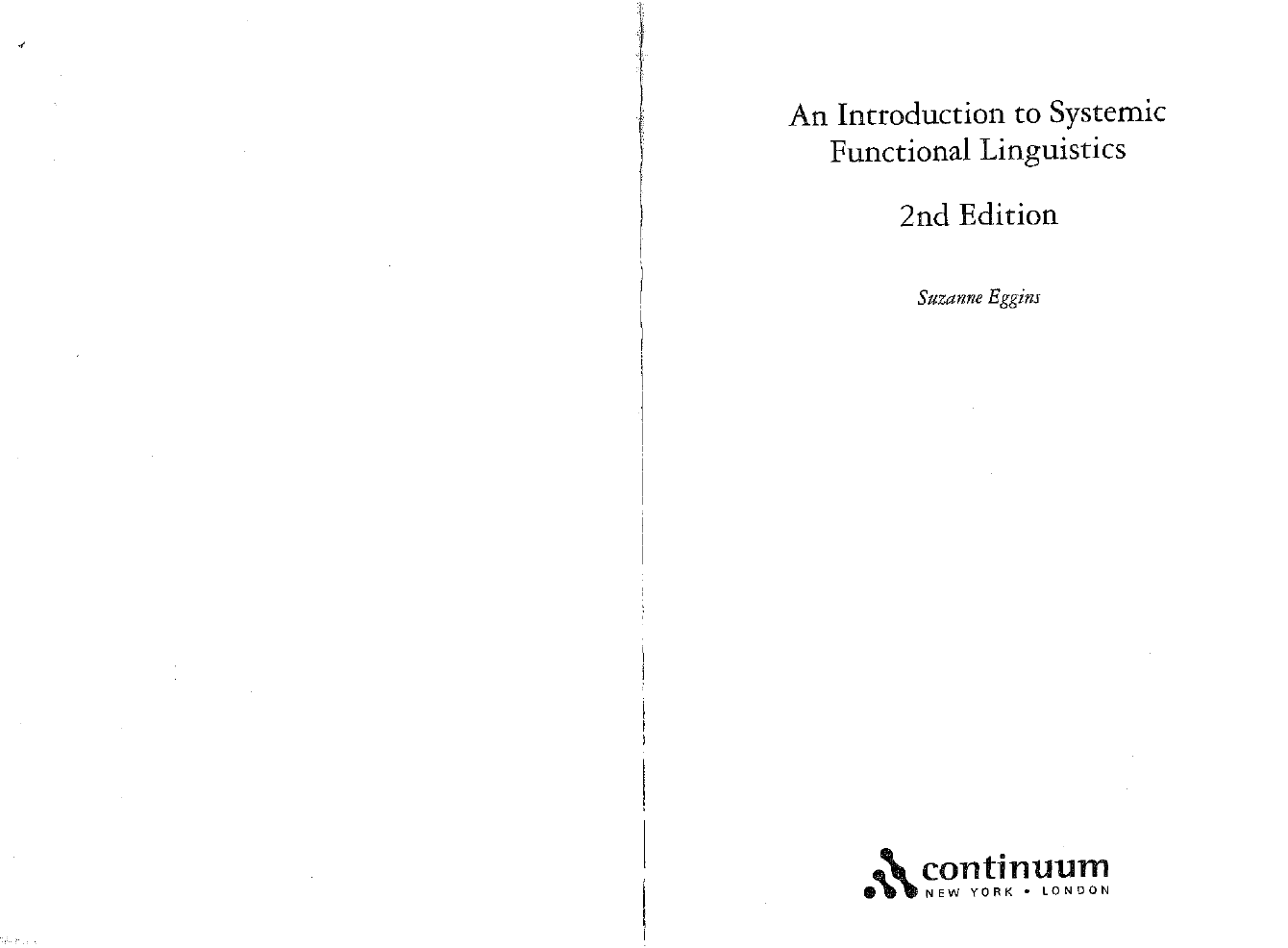
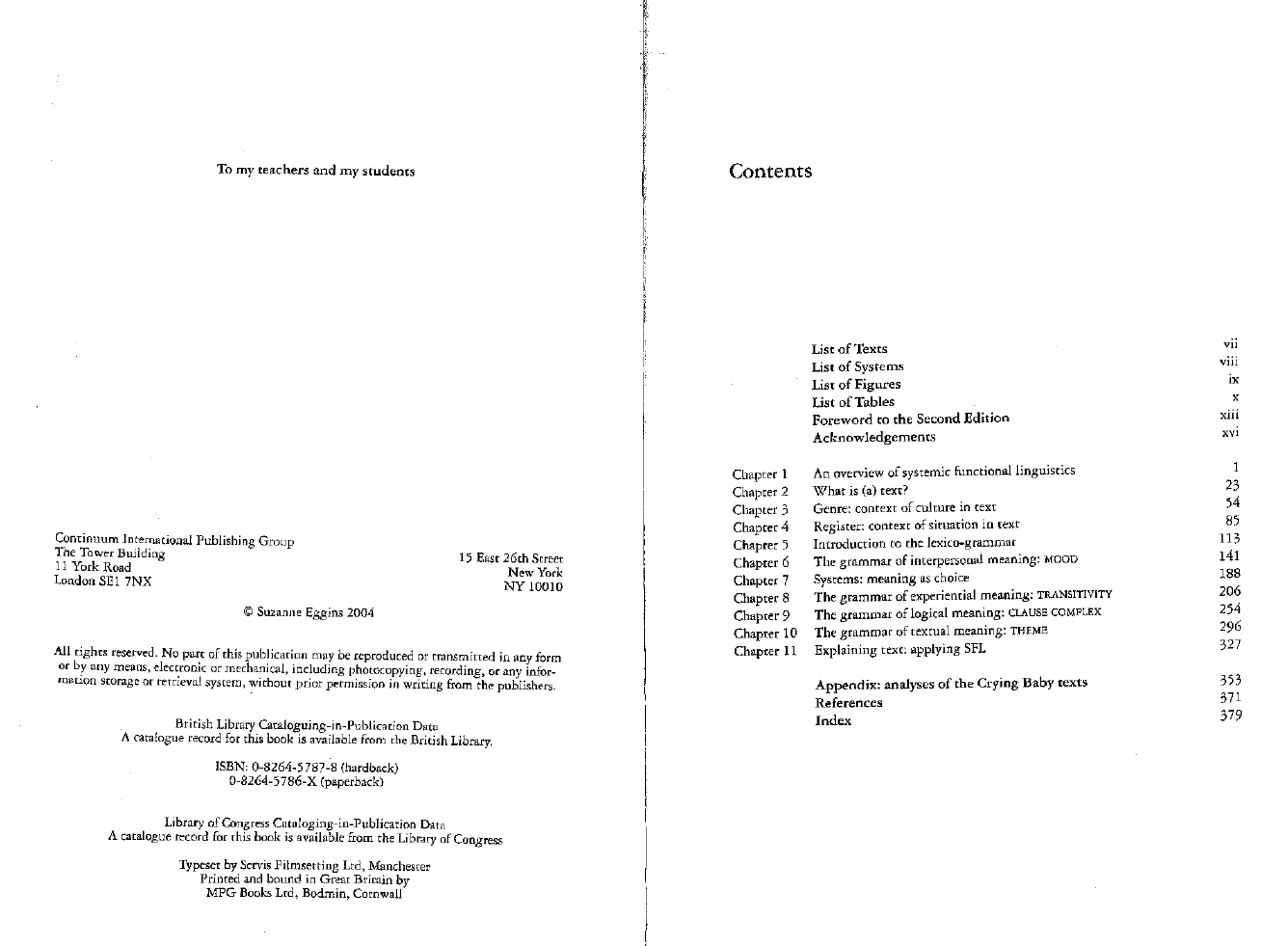

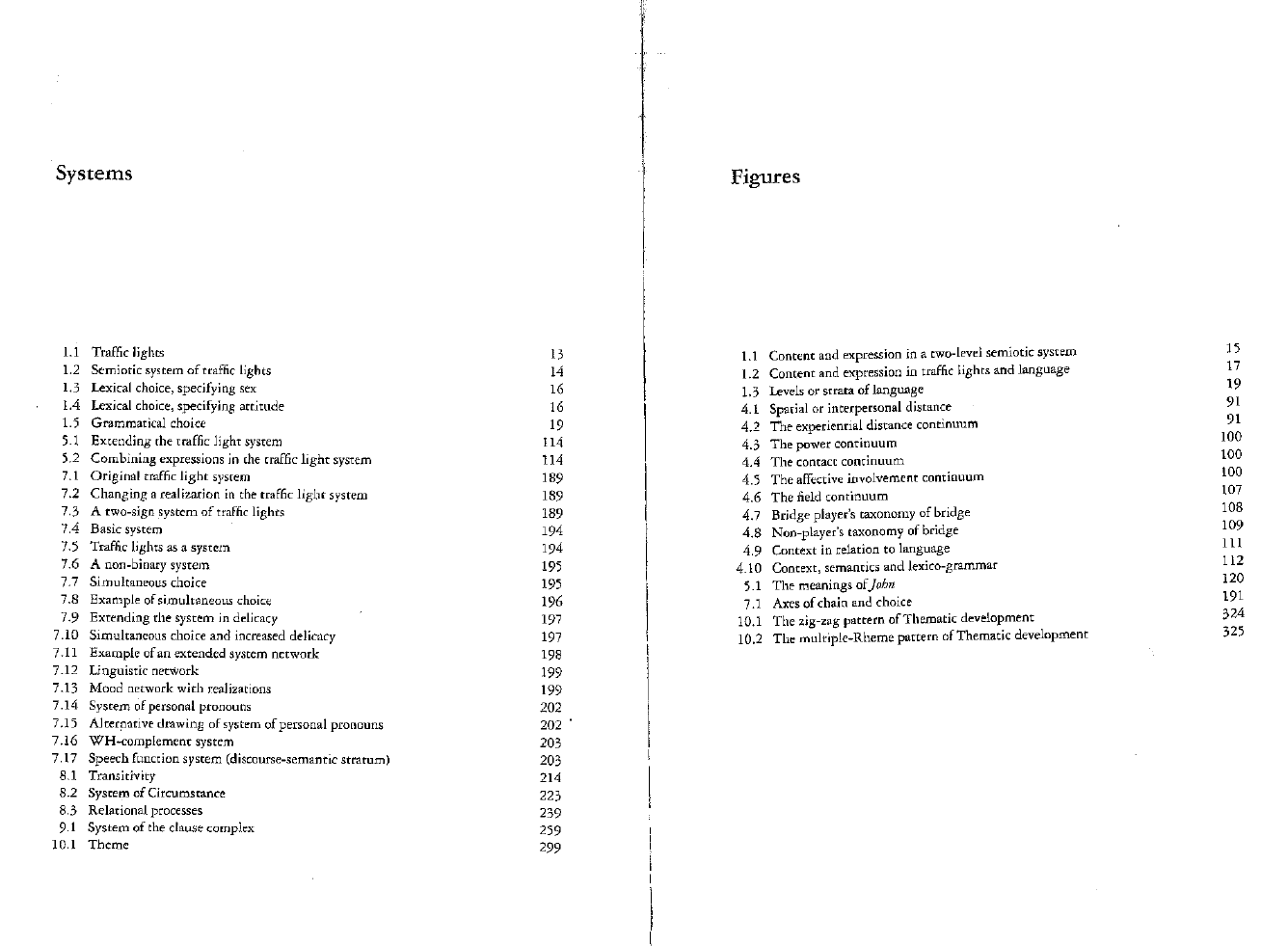
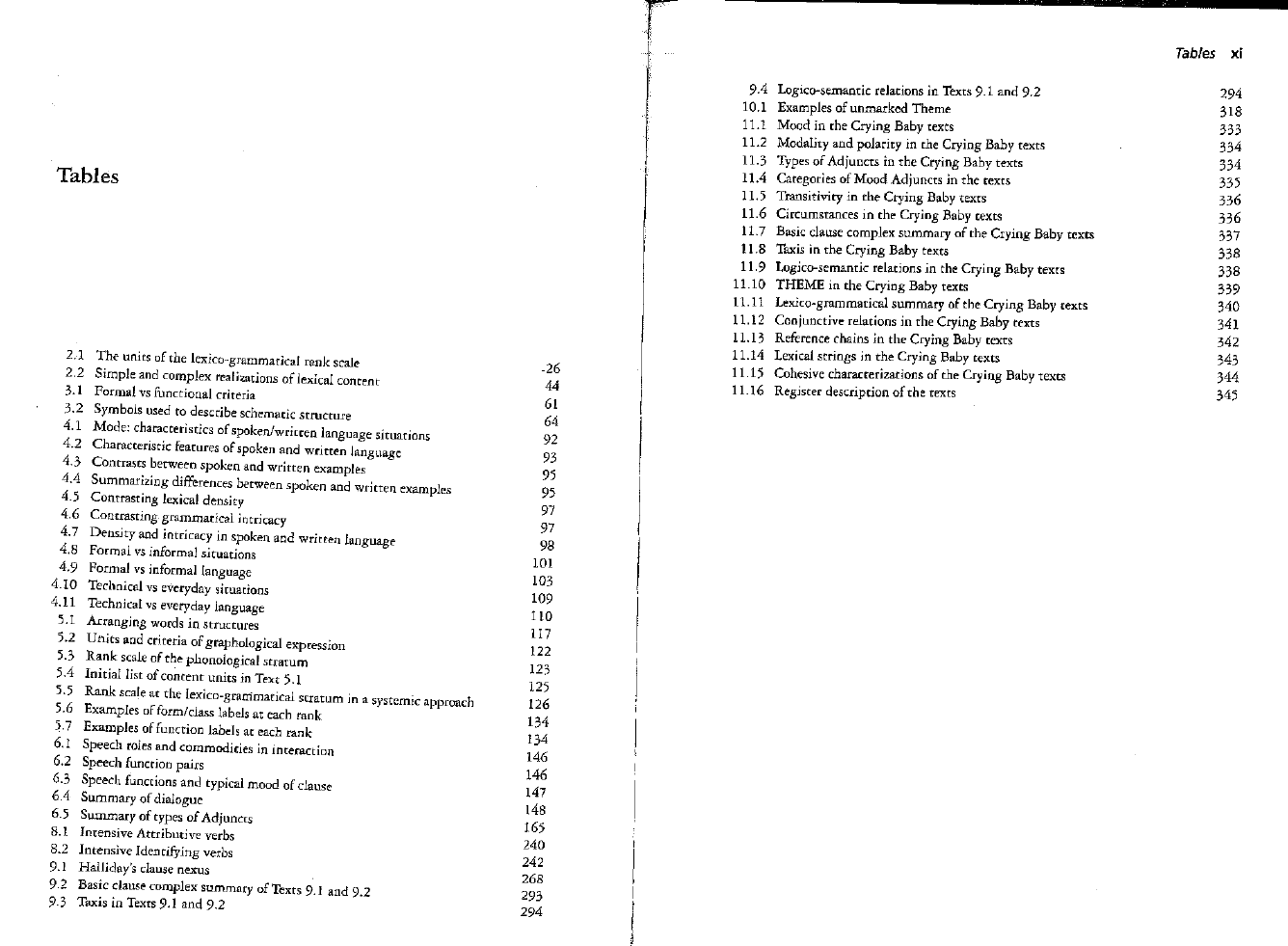

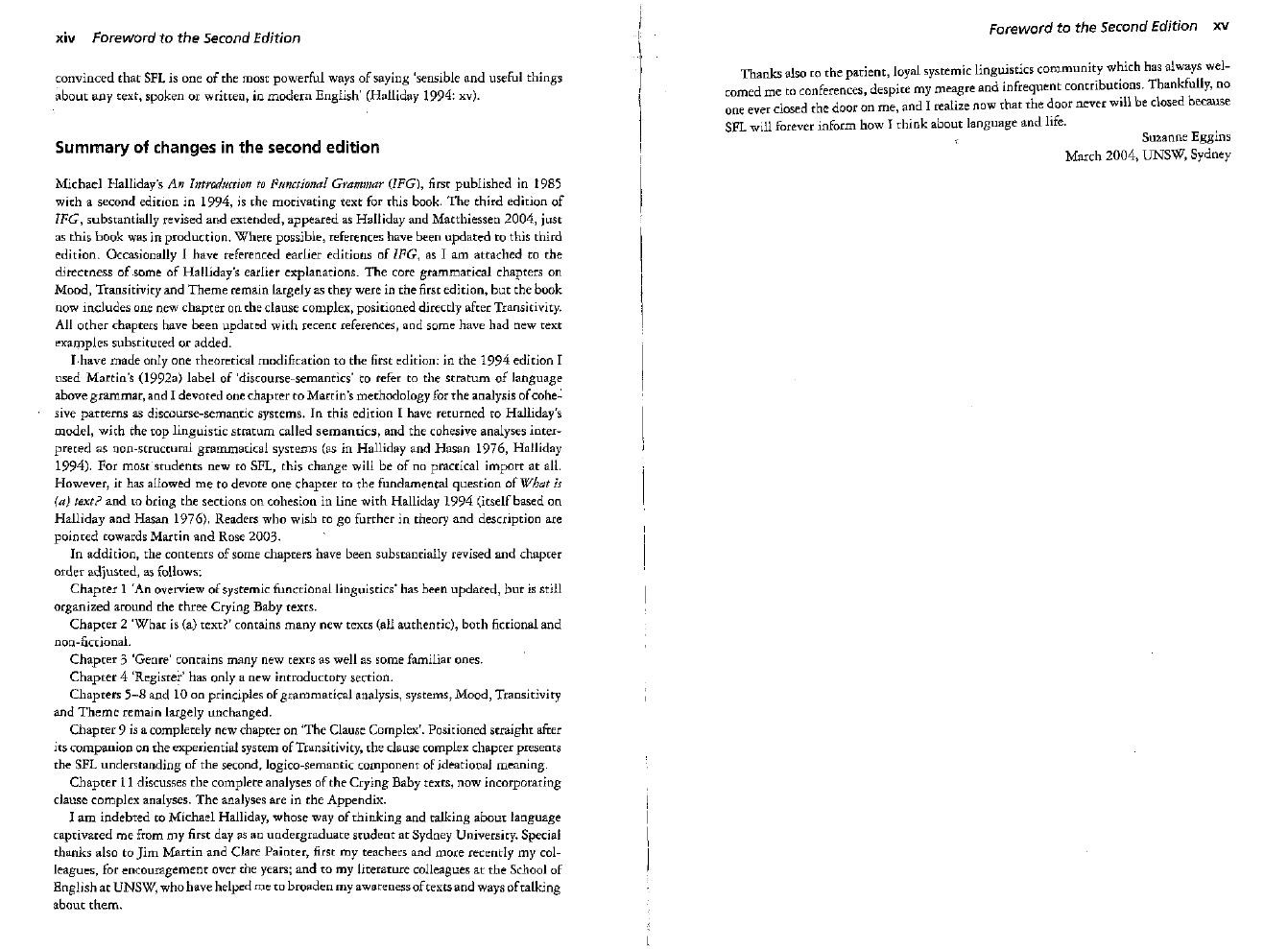
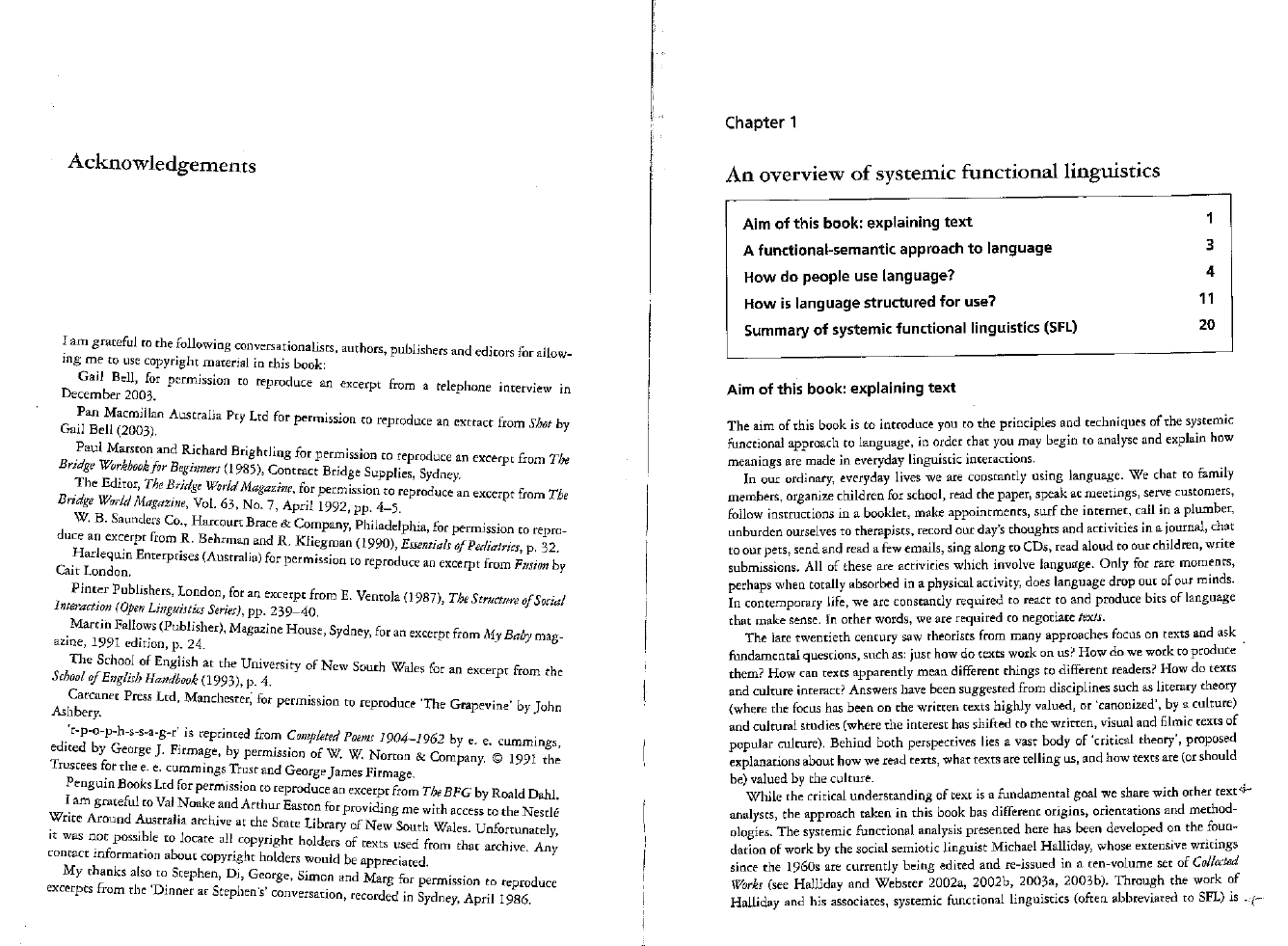








 2023年江西萍乡中考道德与法治真题及答案.doc
2023年江西萍乡中考道德与法治真题及答案.doc 2012年重庆南川中考生物真题及答案.doc
2012年重庆南川中考生物真题及答案.doc 2013年江西师范大学地理学综合及文艺理论基础考研真题.doc
2013年江西师范大学地理学综合及文艺理论基础考研真题.doc 2020年四川甘孜小升初语文真题及答案I卷.doc
2020年四川甘孜小升初语文真题及答案I卷.doc 2020年注册岩土工程师专业基础考试真题及答案.doc
2020年注册岩土工程师专业基础考试真题及答案.doc 2023-2024学年福建省厦门市九年级上学期数学月考试题及答案.doc
2023-2024学年福建省厦门市九年级上学期数学月考试题及答案.doc 2021-2022学年辽宁省沈阳市大东区九年级上学期语文期末试题及答案.doc
2021-2022学年辽宁省沈阳市大东区九年级上学期语文期末试题及答案.doc 2022-2023学年北京东城区初三第一学期物理期末试卷及答案.doc
2022-2023学年北京东城区初三第一学期物理期末试卷及答案.doc 2018上半年江西教师资格初中地理学科知识与教学能力真题及答案.doc
2018上半年江西教师资格初中地理学科知识与教学能力真题及答案.doc 2012年河北国家公务员申论考试真题及答案-省级.doc
2012年河北国家公务员申论考试真题及答案-省级.doc 2020-2021学年江苏省扬州市江都区邵樊片九年级上学期数学第一次质量检测试题及答案.doc
2020-2021学年江苏省扬州市江都区邵樊片九年级上学期数学第一次质量检测试题及答案.doc 2022下半年黑龙江教师资格证中学综合素质真题及答案.doc
2022下半年黑龙江教师资格证中学综合素质真题及答案.doc